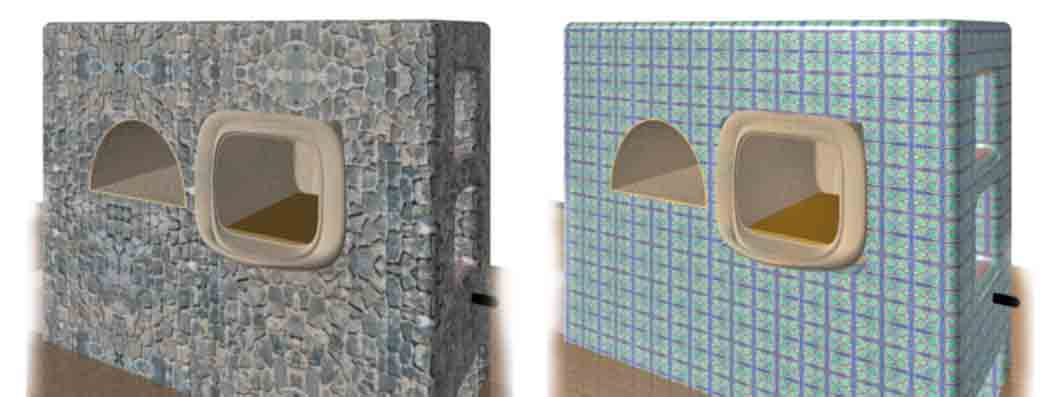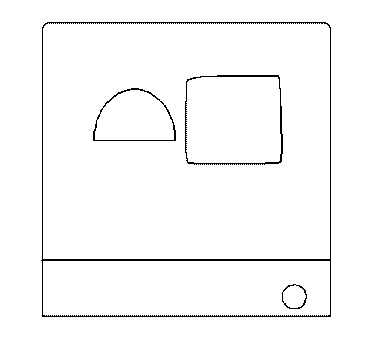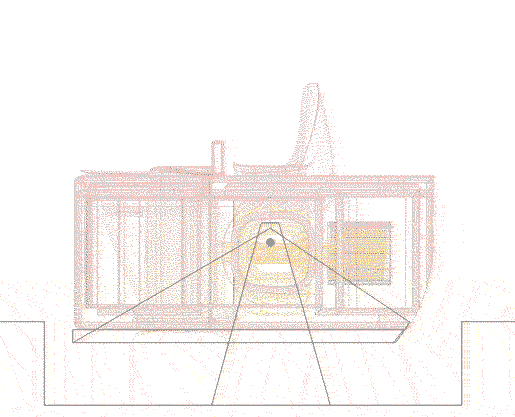
Semi Transparent View
Essentially Monolithic Masonry Heater-- Balanced Tilt Up Construction

Semi Transparent View
CAD precision fits together all the features and more. Familiar features
for masonry heaters are a fireplace-window, cooking-oven, cooking-range.
Less common
features are wood-driers, warming-cubbies and hot-water. Here is a
model which combines as many features as possible. The critical vapor-gaseous
seal important for masonry heaters is addressed with as much monolithic
pouring
as is possible. Working the primary wall surfaces flat, with the aid of
gravity, will best insure the highest possible quality. Therefore the
challenging technique of tilt up construction is offered. Tiles or
thin stones can also be applied with this general method:

Many personalized artistic finishes can be applied. The above rendering intends to show an oven and cooking range( which could be better finished). The technical exploration of the model took most of the available modeling time.

This page is intended primarily for study and inspiration. The current 3D
Cad model is available. Inquiries of all kinds are welcome. Telephone
number and Email address is provided below,
at page bottom.

An insulated fire box simplifies fire-making chores and efficient burning. A cordwood sized firebox offers advantages and is drawn in this particular model. Labor can be saved with less splitting and cutting. An un-insulated firebox can loose too much heat through it's walls. It can take a while to heat up. Unburned fuel is wasted and for longer periods it pollutes the exhaust.
Refractory insulation is not cheap but is like investing money in a useful tool. Cordwood is cheaper for equal heating value, compared with pieces of wood cut short. House-customization can greatly ease cordwood handling. For the frugal-minded wood user, long, insulated fireboxes can make use of wasted brush piles. Collecting longer pieces of wasted wood is less troublesome than cutting and handling short pieces. Ordinary cordwood offers sufficient output for co-generation of electricity with a small steam-generator. (Although such a device would have to be custom built as of 2006). Domestic co-generation would provide excellent backup for the all-solar home. (Shorter 3 ft or 1 meter sized wood makes more sense, especially if harvested oneself. However, the American market is locked into 4 ft cordwood "packaging"). With experience, one can learn to burn "green wood" and generally un-ideal firewood. Best of all, such heaters function without need of electric blowers.
Addition of a small heat-storage-hearth around the base would extend
the heat storage capacity. In fact, this system would highly compliment
PAHS-AGS
houses.
Engineering-redundancy is well respected in a world where so much goes
wrong. Comfort and convenience demand comprehensive dual-use design as
backups.
The feature of artistic and balanced tilt up construction allows for the highest concrete standards to be achieved with the least expense. Instead of one cookie-cutter, commercialist approach, a personalized touch is possible with texture, color and further individualization. The refractory components could be factory derived or sand-cast by a competent artisan. Once made these components doubly serve as much of the internal form work.

Pictures above portray texture derived from real leaves. It is a ferrocement fireplace built to accommodate a gas fire and is presented only as a sample of leaf texture. Here is how leaf texture can be incorporated. Leaves would be placed upon the main tilting platform. A colorful cement slurry would be sprayed over them, to form a gel coat. Then would begin a monolithic concrete pour. After the first wall is poured flat and compacted, prefab parts and wall forms would be placed.

The picture above is a lay-out example for cut outs in the first wall pour. Next picture below: Further components are placed on top of pour. Panel sections can be placed along with other components, all of which could be sand cast in advance. (The tilting axle is not pictured, nor is the needed braced stand.) Various flue dampers and other refractory deflectors are needed to keep heat properly distributed. Ordinary concrete cannot receive high heat directly. Heat must be carefully channeled and dispersed before reaching ordinary concrete surfaces. This is the safe strategy. Refractory castables generally require high firing to gain full strength which would done elsewhere.. According to rule of thumb, Portland based concrete should not be heated beyond food baking temperatures. This is fairly easily prevented by design.

To complete the concrete sandwich: The opposing wall would be poured on top, (and textured). With skilled people, this could happen fast. Use of ready-mix concrete tends to speed work further. Able laborers could otherwise mix on site and complete the pour in a day. As drawn, the amount of concrete is around 4 cubic yards or 4 cubic meters. This amount of ready mix can usually be delivered without a "surcharge for small loads"). Finally, after sufficient curing, the whole composite sandwich is balance-tilted upright, (pivoted on an axle).

The point is, this might be done efficiently and it can be done with little equipment investment. It could be done in new construction sites or in retrofits. The tilted pour allows the finished surfaces to receive the most careful treatment and the most durable compaction, (in the shortest labor time). This aids both the aesthetics and the ultimate strength. Computer aided layout ushers in new advantages for customizing jobs to better suit clients and architects.
By contrast, traditional masonry technique is also possible without the drama of tilting. Which approach achieves the best vapor and gaseous seal is worth inquiry. Reinforcement technique also deserves closer examination. This monolithic-pour philosophy strives to better integrate components to minimize adverse effects. Thin-layered coatings, when used, are generally less stable than are monolithically poured concrete coatings. These issues call for the best workmanship practices and the effort to equalize heating in all parts of the structure.
Vortex Flame Amplifier : Solid Fuel Burner Experimentation
Insulated Firebox Experimentation
Bo's Art Of Burning In Ordinary Stoves (Link to be added)
Note: These pages are placed in the public domain and are furnished "as is". The author assumes no responsibility for the use or misuse of the concepts in this series. All authorities should be satisfied first, as might be required, by relevant laws, before any building proceeds.
Searching Synergy .... .... Free Exchange of Ideas
.... Free Exchange of Ideas
Enersearch was incorporated in 1980 but never materialized financially. A synergy of concepts were developed and are reflected in the pages of this series. The synergy continues as a single handed effort of Bo Atkinson, in Maine, USA.
Email comments welcome ~~~~~~~ boa1@pivot.net
Tel : 207 342 5796 . . . (Maine)